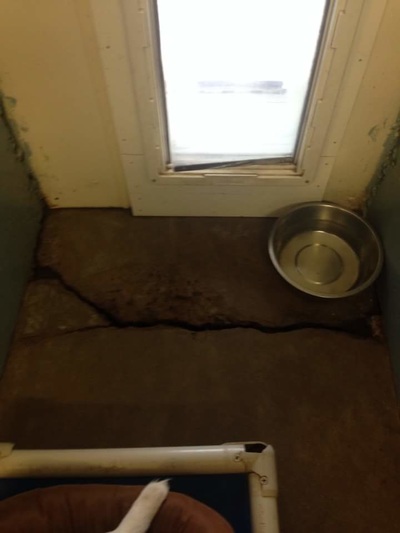Why We Need a New Shelter
Our current building has given us all it has to give. We just fix and patch and trouble shoot issues as they arise and pray the building has one more winter to give.
There are things, however, that cannot be patched or fixed, like the fact that we have no bathrooms for staff or visitors, or that we have virtually no room to treat and or quarantine animals, or a quiet area for people to meet a prospective family member.
- The wood of the building is rotting and the walls have many holes and gaps.
- The electrical wiring is exposed (no conduit) and subject to water and rodent damage.
- The plumbing is deficient and subject to freezing.
- The roof has been patched many times and still leaks; it would not be cost-effective to put a new roof on a building with so many other problems.
- Storage space throughout the shelter is grossly inadequate.
- The floors of the kennel area are constructed of unsealed, corrugated concrete which harbors pathogens, and the lack of drains requires an arduous cleaning process.
- The dog kennel area has no climate control, leaving dogs exposed to below-freezing temperatures in winter and 90-degree temperatures in summer.
- The leaking roof leaves dogs standing in water when it rains.
- The chain link kennels are inadequate for proper separation of dogs and control of airborne disease.
- There is no meet and greet space for potential adopters to spend time with individual dogs or cats.
- There is poor climate control and ventilation in the cat rooms and work areas.
- There is inadequate space for cats, especially new intakes who need to be isolated.
- The only space for sick cats is 4 cages in a different wall within the same space.
- There is no space for staff and volunteers to hold meetings, have breaks, or go to the bathroom to wash up after handling sick animals.
For the animals, a new shelter means:
More humane space to hold adoptable animals, enabling us to save even more animals and give them a second chance at a forever home.
- Less stress and reduced overcrowding and congestion for pets and people.
- More comfortable and sanitary space for animals
- An exam rooms eliminating disturbances between animals.
- Reduced risk of spreading contagious diseases among shelter animals
- Visitors will have an actual lobby and reception area where they can inquire about adoption, spay/neuter and other services without the stress of all animals being in the same room.
- A welcoming atmosphere with adequate space for adoption activities, such as family discussion, interaction with the animal, and having the prospective animal meet with existing family animals.
- A sanitary and pleasant work/volunteer environment where people will want to visit, volunteer and work.
- Break areas where employees can enjoy a break or lunch.
- Separate airflow/ventilation system from animal areas to ensure the health of individuals who visit, work and volunteer at CHA.

















